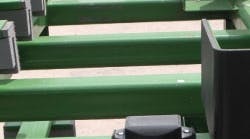Whether you’re a farmer or an occasional weekend gardener, almost everyone recognizes the green and yellow colors associated with John Deere. The company is one of the world’s leading manufacturers of farm equipment, and produces and markets one of North America’s broadest lines of lawn and garden tractors, mowers, golf course equipment, and other outdoor power products.
Many John Deere products are large and heavy. Consequently moving service parts, components for manufacturing, and finished goods throughout the world is a daunting logistical challenge. Deere has manufacturing operations in Russia, China, India, Brazil and other countries, as well as over a dozen locations in the U.S. Reusable packaging is used primarily for manufacturing components, but also for service parts and small finished goods such as lawn and garden tractors.
Deere is one of the top 30 manufacturing companies in tonnage of global imports/exports. Because logistics is so critical to the enterprise and because global ambitions included expanding manufacturing to different parts of the world, the Department of Worldwide Logistics was organized in 1999 as a core competency of the company. Centralized management of reusable containers was part of the initial strategy. Today, Deere owns about 1,500,000 reusable containers that are used to ship everything from nuts and bolts to hoods and engines.
Deployment and Tracking
Deere defines “returnable” as a customized special-use container that must be returned to its point of origin, so obviously reverse logistics is critical. “Reusable” is defined as a generic container that, once emptied, has no defined return-to location. The challenge is to quickly and efficiently relocate the empty reusable to a nearby point of need. The goal is to minimize the distance to the next point of use without enduring too much dwell time waiting for a need to develop.
To effectively manage its reverse logistics, Deere developed a sophisticated and integrated tracking system throughout its global supply chain. Its 1,500,000 containers each have some sort of tracking tag affixed to them and are tracked through an Internet-based tracking system. An ability to track container assets is essential to effectively managing a global network where containers are constantly moving somewhere 24 hours a day.
Without a tracking system, the probability of shrinkage increases as geography expands, to the point that it undermines the financial viability of investing in reusable containers. An integrated tracking/management system provides the strongest and best value proposition by harvesting numerous benefits from the same infrastructure.
Deere’s returnable/reusable containers come in many forms. At the high-cost end, it uses $500 custom racks to transport high appearance parts such as tractor hoods that cannot have any contact with other parts or with packaging material, except for specific points of attachment.
Next, the company has standard generic bulk containers that contain permanently affixed customized dunnage, so these units must also be returned to their point of origin. Its greatest quantity of containers is generic, and might never travel the same route twice. The value of the container and the nature of its route determine the type of tracking tag used.
RFID’s Role
High-cost containers in multi-stop, long-distance loops warrant active RFID, featuring automated verification of arrival and periodic monitoring of dwell in each location. It is common to query active tags in each location every five minutes. Passive RFID is deployed on containers that naturally flow through a central location.
One example is containers sent to dealers from centralized part distribution centers. Another example is Enviro-crates, reusable, stackable, steel, fold-down containers used to ship lawn and garden tractors to dealers and to mass marketers such as Lowes and Home Depot. Passive RFID readers automatically verify that each container has returned to the DC from its latest deployment.
Manual scanning of bar codes is still the most common input into the company’s tracking system, especially for small inexpensive totes used for fasteners and fittings, but manual scanning is more labor intensive and less reliable than RFID. All bar-coded tags purchased in recent years also contain RFID chips, so over time the percentage of manual scans will diminish as the company’s RFID infrastructure is expanded.
Deere does not yet put a $10 active RFID tag on many containers. It deploys active tags when it is important to continuously know where a container is within the supplier’s facility or at any other location in the supply chain, such as an intervening stop for painting, plating, or subassembly.
The company puts passive RFID tags on all other reusable bulk containers. It does not believe manually scanning bar-codes will ever provide the level of accuracy needed to support continuous improvement. However, both passive and active tags also feature barcodes and human-readable printing, so all tags can use lesser technology when appropriate.
How Info is Used
Regardless of the source of tracking input, all information flows into an integrated system. This information is used for planning, performance metrics and monitoring custody of reusable containers.
One such performance metric is accuracy in delivering the right product to the right customer. Delivery errors were essentially eliminated by installing stop-and-go lights on the dock doors of a DC for turf care products. Product serial numbers are associated with that of the specific delivery crate used to package units at the end of the assembly line. The serial number of the delivery crate is read as it enters each truck and triggers a green light only after being verified as correct.
An integrated tracking/management system provides the strongest and best value proposition by harvesting numerous benefits from the same infrastructure.
As mentioned earlier, Deere’s “reusable” containers have no identified next destination once they are emptied. The company’s goal is to relocate empty containers to a point of need that is much closer than the point of origin of that cycle. “Returnable” containers, by definition, must travel a mile empty for every mile full. The ratio of empty miles to full miles is a measure of how effectively reusable containers are managed.
Almost all empty containers flow from factories to processing centers, which are strategically located close to major factories. Four of the processing centers are in U.S. Others are in Germany, Spain and Mexico.
Financial Justification
Benefits derived from deploying reusable containers can be loosely categorized into non-quantifiable and quantifiable savings. Non-quantifiable savings are very real and important, but difficult to capture.
Safety is always a first consideration. While plastic and even steel containers can fail, it is less likely than with cardboard. Their strength remains consistent, even in moist environments. Deere de-rates the manufacturer’s stated capacity by 25% for most of its applications. Wood tends to splinter, creating its own hazard.
Quality is improved. Material in containers is less likely to be damaged during transit and handling because reusable containers are typically more resistant to puncture and structural failure.
Housekeeping also is an important consideration. Reusable containers fall into a limited number of footprints, so they lend themselves well to the time honored adage, “a place for everything and everything in its place.”
Being environmentally responsible is a foundational value of John Deere. An increasingly appreciated benefit of reusable packaging is its lessened environmental impact. An environmental study published by the Reusable Packaging Association concluded that landfill requirements decreased by 90 percent when using reusables.
And despite requiring return transportation, life cycle energy consumption and carbon emissions were lower than those of expendable packaging. All of Deere’s end-of-life scrap is sent to one of its primary suppliers to regrind into new containers.
Most of the company’s quantifiable savings, about 85 percent, are attributed to lower expense for expendable packaging. For example, instead of packaging lighting brackets in two heavy-duty 24” x 24” x 36” cardboard boxes ($21 each) on an $8 wood pallet, the material can be packed in a 45” x 48” x 34” reusable container that costs less than $20 to cycle.
Other significant savings result from reduced cost of disposal, and improved transportation density. While Deere attributes only 7 percent of its total savings to greater payload of material trucked into the company’s factories, its potential is much higher. Although Deere manufactures heavy equipment, it has enough lightweight material to often cube-out trucks before they reach allowable weight. Stackable containers often enable additional material to fit on a truck, thus getting a free ride.
The Future
The future of tracking technology is as unpredictable as anything else, but the trend of lower cost for high level devices such as passive and active RFID tags suggests that automation will soon eliminate manual scanning. More powerful container management software will better predict the forthcoming needs of each supplier, for each type of reusable container, and will optimize cost by building better loads and optimizing return routes.
Another level up is Wi-Fi technology. Not long ago, the cost of a Wi-Fi tag was $50. They’re now about $30—substantially less if purchased in high volumes, so that might be a tracking possibility.
Whether it is Wi-Fi or other emerging new technology, Deere is continually looking for new ways to reduce costs and continually improve the efficiency of its supply chain. Regardless of the technology, reusables will remain a constant in its operations.
Jerry Welcome is president of the Reusable Packaging Association. He wrote this with input from Lyle Schmitt, manager of global packaging and quality for John Deere, and member of the Reusable Packaging Association. The content of this article was originally delivered at the Reusable Packaging Association Fundamentals of Reusable Packaging Workshop at PACKEXPO in 2010.



